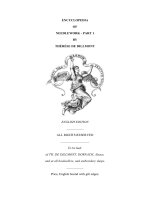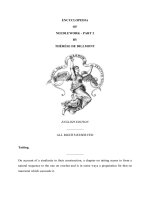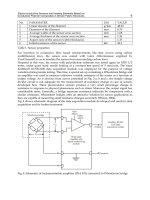An Encyclopedia of the History of Technology part 2 doc
Bạn đang xem bản rút gọn của tài liệu. Xem và tải ngay bản đầy đủ của tài liệu tại đây (94.28 KB, 10 trang )
CONTENTS
x
Gliders 621
The Wright brothers 622
European pioneers 624
Military and commercial applications 626
The inter-war years 629
The Second World War 632
Demise of the flying-boat 633
Expansion of civil aviation 634
Introduction of jet propulsion 634
Jet airliners 637
Supersonic commercial aircraft 639
Jet-supported flight 639
Helicopters and rotary wings 641
Convertible and hybrid aircraft 644
Recreational aircraft and gliders 644
Man-powered flight 646
13. Spaceflight 648
John Griffiths
Black powder rockets 648
Spaceflight pioneers 649
Vengence Weapon Two 649
Post-War research 651
Manned spaceflight and the space race 652
Satellite technology 656
Probes to the moon 658
Probes to the planets 659
Launch vehicles 661
PART FOUR: COMMUNICATION AND CALCULATION 663
14. Language, Writing, Printing and Graphic Arts 665
Lance Day
Language 665
Writing 666
The invention of printing 669
The growth of printing 671
Technological innovation in the nineteenth century 674
Colour printing 681
Office printing 682
Optical character recognition 684
CONTENTS
xi
15. Information: Timekeeping, Computing, Telecommunications and
Audiovisual Technologies 686
Herbert Ohlman
Introduction 686
The evolution of information technologies 687
The timing of inventions 691
Timekeeping 694
Counting, calculating and computing 698
The telegraph 710
The telephone 717
The gramophone 720
Radio and radar 725
Photography 729
Facsimile and television 743
Communications satellites 746
Information storage today 748
PART FIVE: TECHNOLOGY AND SOCIETY 759
16. Agriculture: The Production and Preservation of Food and Drink 761
Andrew Patterson
Introduction 761
Hunter gatherer to farmer 762
Arable farming 767
Sowing 772
Fertilizers 774
Pest control 775
Weed control 777
Crop rotation 779
Harvesting 779
Farm traction 787
Dairy farming 791
Poultry farming 796
Food preservation 796
Conclusion 801
17. Textiles and Clothing 803
Richard Hills
Introduction 803
Textile fibres 804
Early textile processes 808
The Middle Ages 812
The seventeenth and early eighteenth centuries 818
CONTENTS
xii
The industrial revolution 823
The nineteenth and twentieth centuries 835
Velvet, towelling and carpet weaving 845
Knitting machines 846
Lace machines 848
Sewing machines 848
Man-made finishes and fibres 849
Clothing manufacture 850
Sewing 851
Fastenings 852
Waterproof clothing and elastic 853
Cleaning 854
Footwear 854
18. Building and Architecture 855
Doreen Yarwood
Primitive building 855
Trabeated construction 857
Masonry 859
Advanced timber construction 861
Brick and tile 866
The arch 872
The vault 874
The dome 879
Cantilever construction 882
Roofing 883
Plaster 885
Concrete and cement 886
Iron and glass 893
Modern industrial construction 899
19. The Domestic Interior: Technology and the Home 902
Doreen Yarwood
Surfaces, coverings and decoration 902
Furnishings and furniture 906
Heating and lighting 911
Washing, bathing and toilet facilities 917
Cleaning in the home 922
Laundering 928
The kitchen and cooking 934
Plastics in the home 947
CONTENTS
xiii
20. Public Utilities 949
R.A.Buchanan
Introduction 949
Water supply 950
Power supply 957
Waste disposal 962
Roads and postal services 963
Telegraph and telephone services 964
Conclusion 966
21. Weapons and Armour 967
Charles Messenger
Prehistoric weapons 967
The bronze age and classical era 968
The Dark Ages 971
The age of chivalry 972
The introduction of gunpowder 975
The Renaissance 976
Seventeenth and eighteenth centuries 978
The industrial age 983
The First World War 989
The Second World War 998
Weapons today 1006
The Contributors 1012
Index of Names 1018
Index of Topics 1033
xiv
PREFACE
Dr Johnson wrote, ‘A man may turn over half a library to make one book’.
In the present case around a score of writers have turned over about as
many libraries to make this Encyclopaedia. The Book of Proverbs states,
‘God hath made man upright; but they have sought out many inventions’.
Whatever one may think about Charles Darwin’s ‘Descent of Man’, it is a
fact that man walked upright, giving him a pair of hands which he could
use for manipulation, rather than ambulation, and his cranial capability
enabled him to evolve many inventions. This book tells the story of these
inventions from stone axe to spacecraft, from cave dwelling to computer.
The objective has been to simplify the study of the History of Technology
by putting into the hands of the reader, be he or she student or layman, a
single volume telling the whole story in twenty-two chapters, each written
by an acknowledged expert.
The content and layout of this book are based on an analysis of human
needs. From earliest times man has existed in a fundamentally hostile
environment and has had to use his wits in the struggle for survival. From
the start, this has involved his remarkable power of invention. Other
primates, such as chimpanzees, have been known to add one stick of
bamboo to another to enable them to reach and hence to enjoy a banana
otherwise out of reach. Many species of birds show remarkable ingenuity in
the construction of their nests, while insects like the ant, the wasp and the
bee display a constructive capacity which could be mistaken for genuine
creativity, but these examples are no more than instinctive and isolated
responses to a set of circumstances peculiar to the species. Only God knows
why man is the only species of animal capable of inventive thought and
equipped with the dexterity to make practical use of his ideas.
The Encyclopaedia had its inception during the period when I was
Executive Secretary of the Newcomen Society for the Study of the History
of Engineering and Technology, and worked from an office within the
Science Museum in London’s South Kensington. In this position I was able
to call upon a host of specialists, many of whom are members of the
Society, and some also on the curatorial staff of that excellent institution.
Thus while the conception, chapter contents and planning were my
PREFACE
xv
responsibility, the execution of the work was dependent on the contributors.
I would like to thank them all for keeping to my original plan and layout,
only adding topics that I had inadvertently omitted, and for the excellent
chapters that they have written.
The final text has benefited enormously from the work of Mrs Betty
Palmer who has laboured hard and long to cut out duplications, correct
errors and generally shape the disparate typescripts into a uniform and
coherent style. I would like to record my thanks to her, as well as to
Jonathan Price and Mark Barragry of Routledge for their patience, good
humour and encouragement. My gratitude must also go to the proof
readers John Bell, George Moore and Jenny Potts and to the indexer, Dr
Jean McQueen, whose work has contributed so much to the usefulness of
the Encyclopaedia. I would like also here to acknowledge the generosity of
the Trustees of the Science Museum for permission to reproduce over 60 of
the illustrations contained in this book and thank the staff of the Science
Museum Photographic Library for their assistance in tracking down
photographs sometimes specified only vaguely.
Lastly I would like to thank my wife for her patience and forbearance.
The period of gestation of this book has been longer than the others I have
written and has caused a greater amount of paperwork to accumulate
around my desk than usual. She has put up with it all with admirable
fortitude.
Ian McNeil
Banstead, Surrey
To the memory of
THOMAS NEWCOMEN
who built
the first engine to work
without wind, water or muscle power
1
INTRODUCTION
BASIC TOOLS, DEVICES
AND MECHANISMS
IAN McNEIL
THE PLACE OF TECHNOLOGY IN HISTORY
It is strange that, in the study and teaching of history, so little attention is paid
to the history of technology. Political and constitutional history, economic
history, naval and military history, social history—all are well represented and
adequately stressed. The history of technology is neglected in comparison yet,
in a sense, it lies behind them all. What monarchs and statesmen did in the
past, how they fought their wars and which side won, was largely dependent
on the state of their technology and that of their enemy. Their motivation was
more often than not economic, and economic history and the history of
technology can surely be considered as twin hand-maidens, the one almost
totally dependent on the other. So far as social history is concerned, the lot of
the common man, as of his king and his lords, was usually directly related to
the state of technology prevailing at any particular time and place, whatever
political and economic factors may also have been of influence.
Technology is all around us: we live in a world in which everything that
exists can be classified as either a work of nature or a work of man. There is
nothing else. We are concerned here with the works of man, which are based
on technological and, to some extent, aesthetic factors. It is a sobering thought
that every man-made object of practical utility has passed through the process
of conception, testing, design, construction, refinement, to be finally brought to
a serviceable state suitable for the market. Aesthetics may have entered into the
process of development and production at some stage, increasingly so in our
present consumer age, although from a glance at some of the products on the
market, one might well question the makers’ artistic sensibility.
It is even more sobering, however, to try to contemplate a world in which one had
absolutely no knowledge of history, of one’s own country or of the world at large. It









